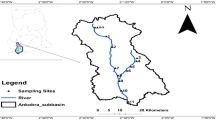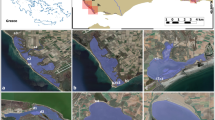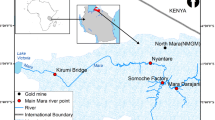Abstract
The objectives of this study were to assess the sediment contamination with heavy metals and to investigate accordingly the ecological risk posed in the SE of the Danube Delta. Sediments are important in assessing the contamination as they act as reservoirs, transporters and contamination sources. Sediment samples were collected and analysed for lead, cadmium, arsenic and mercury, revealing levels higher than the background, especially for cadmium and mercury (Pb > As > Cd > Hg). Concentrations exceeding the probable effect limit were noticed for arsenic and mercury. The contamination indexes describe the study area as having almost half of the samples as contaminated (pollution load index-PLI 1.04), however the contamination is mostly low-to moderate (modified contamination degree-mCd 1.36). The sediment contamination poses mostly a low ecological risk (RI 94.8). The sediment quality guideline quotient (SQG-Q 0.29) describes a moderate impact, while the probable effect concentration quotient (PEC-Q 0.16) confirms that there are no levels likely to affect the aquatic biota. In our study area, the main Branch of the Danube River and the Secondary Delta are the most affected by contamination, while the narrow, reed abundant channels as the preferred habitat of most aquatic organisms, have a low contamination level.



Similar content being viewed by others
References
Abrahim GMS, Parker PJ (2008) Assessment of heavy metal enrichment factors and the degree of contamination in marine sediment from Tamaki Estuary, Auckland, New Zeeland. Environ Monit Assess 136:227–238
Banu Z, Chowdhury SA, Hossain D, Nakagami K (2013) Contamination and ecological risk assessment of heavy metal in the sediment of Turag River, Bangladesh: an index analysis approach. J Water Res Prot 5:239–248
Burton GA Jr (2002) Sediment quality criteria in use around the world. Limnology 3:65–75
Chakravarty M, Patgiri AD (2009) Metal pollution assessment in sediments of the Dikrong River, NE India. J Hum Ecol 27(1):63–67
Dinescu LC, Steinnes E, Duliu OG, Ciortea C, Sjøbakk TE, Dumitru DE, Gugiu MM, Haralambie M (2004) Distribution of some major and trace elements in Danube Delta lacustrine sediments and soils. J Radioanal Nucl Chem 262(2):345–354
Duong HV, Han S (2011) Benthic transfer and speciation of mercury in wetland sediments downstream from sewage outfall. Ecol Eng 37(6):989–993
Filgueiras AV, Lavilla I, Bendicho C (2004) Evaluation of distribution, mobility and binding behaviour of heavy metals in surficial sediments of Louro River (Galicia, Spain) using chemo metric analysis: a case study. Sci Total Environ 330(1–3):115–129
Gati G, Pop C, Brudasca F, Gurzau AE, Spinu M (2013) Assessment of the heavy metal contamination in the Danube Delta from the bioaccumulation perspective. Glob J Hum Soc Sci 13(8):11–16
Gati G, Pop C, Brudasca F, Gurzau AE, Spinu M (2015) Hydrological modeling of arsenic in the Danube Delta. Environ Eng Manag J (in press)
Guieu C, Martin M (2002) The level and fate of metals in the Danube River Plume. Estuar Coast Shelf Sci 54:501–512
Hakanson L (1980) An ecological risk index for aquatic pollution control. A sedimentological approach. Water Res 14:975–1001
Hutton M (1987) Human health concerns of lead, mercury, cadmium and arsenic. In: Hutchinson TC, Meema KM (eds) Lead, mercury, cadmium and arsenic in the environment. Wiley, New York
Keil DE, Berger-Ritchie J, McMillin GA (2010) Testing for toxic elements: a focus on arsenic, cadmium, lead, and mercury. Lab Med 42(12):735–742
Kumar B, Kumar S, Mishra M, Prakash D, Singh SK, Sharma CS, Mukherjee DP (2011) An assessment of heavy metals in sediments from two tributaries of lower stretch of Hugli estuary in West Bengal. Arch Appl Sci Res 3(4):139–146
Li J (2014) Risk assessment pf heavy metals in surface sediments from the Yanghe river, China. Int J Environ Res Public Health 11:12441–12453
Liu ZJ, Zhang XL, Li P, Zhu LH (2012) Regional distribution and ecological risk evaluation of heavy metals in surface sediments from coastal wetlands of the Yellow River Delta. Huan Jing Ke Xue 33(4):1182–1188
Long ER, MacDonald DD (1998) Recommended uses of empirically derived, sediment quality guidelines for marine and estuarine ecosystems. Hum Ecol Risk Assess 4:1019–1039
Long ER, Ingersoll CG, MacDonald DD (2006) Calculation and uses of mean sediment quality guideline quotient: a critical review. Environ Sci Technol 40:1726–1736
Lu SC, Zhang H, Shan BQ, Li LQ (2013) Spatial distribution and ecological risk assessment of heavy metals in the estuaries surface sediments from the Haihe River Basin. Huan Jing Ke Xue 34(11):4204–4210
MacDonald DD, Ingersoll CG, Berger TA (2000) Development and evaluation of consensus based sediment quality guidelines for freshwater ecosystems. Arch Environ Contam Toxicol 39:20–31
Nasir UP, Harikumar PS (2011) Ecotoxicology and ecosystem health of Ramsar Wetland System of India. J Environ Prot 2:710–719
Nikolaidis NP, Dobbs GM, Chen J, Lackrovic JA (2004) Arsenic mobility in contaminated lake sediments. Environ Pollut 129(3):479–487
Ogbeibu AE, Omoigberale MO, Ezenwa IM, Eziza JO, Igwe JO (2014) Using pollution load index and geoaccumulation index for the assessment of heavy metal pollution and sediment quality of the Benin River, Nigeria. Nat Environ 2(1):1–9
Ong MC, Menier D, Shazili NAM, Kamaruzzaman BY (2013) Geochemical characteristics of heavy metals concentration in sediments of Quiberon Bay Waters, South Brittany, France. Orient J Chem 29(1):39–45
Panin N (1996) Danube Delta genesis, evolution, geological setting and sedimentology, Geo-Eco-Marina, RCGGM, 1/1996: 7–23
Pelley J (1999) North Carolina considers controls to protect contaminated waters. Environ Sci Technol 33(1):10A
Peng JF, Song YH, Cui XY, Qiu GL (2009) The remediation of heavy metals contaminated sediment. J Hazard Mater 161:633–640. doi:10.1016/j.jhazmat.2008.04.061
Protano C, Zinna L, Giampaoli S, Spica VR, Chiavarini S, Vitali M (2014) Heavy metal pollution and potential ecological risks in river: a case study from southern Italy. Bull Environ Contam Toxicol 92:75–80
Rabee AM, Al-Fatlawy YF, Najim H, Nameer M (2011) Using pollution load index (PLI) and geoaccumulation index (I-Geo) for the assessment of heavy metals pollution in Tigris River sediment in Baghdad Region. J Al-Nahrain Univ 14(4):108–114
Rahman MS, Saha N, Molla AH (2013) Potential ecological risk assessment of heavy metal contamination in sediment and water body around Dhaka export processing zone, Bangladesh. Environ Earth Sci. doi:10.1007/s12665-013-2631-5
RN (2006) Romanian Normative framework 161/2006 regarding the rating of the water surfaces for setting the ecological status of water bodies, Romanian Official Monitor, no 511
Seshan BRR, Natesan U, Deepthi K (2010) Geochemical and statistical approach for evaluation of heavy metal pollution in core sediments in southeast coast of India. Int J Environ Sci Tech 7(2):291–306
Simpson SL, Batley GE (2003) Disturbances to metal partitioning during toxicity testing of iron(II)-rich estuarine pore waters and whole sediments. Environ Toxicol Chem 22(2):424–432
Simpson SL, Rochford L, Birch GF (2002) Geochemical influences on metal partitioning in contaminated estuarine sediments. Mar Freshw Res 53(1):9–17
Simpson SL, Maher EJ, Jolley DF (2004) Processes controlling metal transport and retention as metal-contaminated groundwaters efflux through estuarine sediments. Chemosphere 56(9):821–831
Sindilariu PD, Freyhof J, Wolter C (2006) Habitat use of juvenile fish in the lower Danube and the Danube Delta: implications for ecotone connectivity. Hydrobiologia 571:51–61
Smedley PL, Kinniburgh DG (2002) A review of the source, behaviour and distribution of arsenic in natural waters. Appl Geochem 17(5):517–568
Smith SL, MacDonald DD, Keenleyside KA, Ingersoll CG, Field LJ (1996) A preliminary evaluation of sediment quality assessment values for freshwater ecosystems. J Great Lakes Res 1996(22):624–638
Tomlinson DL, Wilson JG, Harris CR, Jeffrey DW (1980) Problems in the assessment of heavy metal levels in estuaries and the formation of a pollution index. Helgolander Meeresuntersuchungen 33(1–4):566–575
USEPA (United States Environmental Protection Agency) (2000) Prediction of sediment toxicity using consensus-based freshwater quality guidelines
Wohl E (2012) A world of rivers. The University of Chicago Press, Chicago. ISBN: 9780226007601
Yu R, Ji J, Yuan X, Song Y, Wang C (2012) Accumulation and translocation of heavy metals in the canola (Brassica napus L.)-soil system in Yangtze River Delta, China. Plant Soil 353:33–45
Acknowledgements
The current study was accomplished with the support of the DeltaBioTox research project, supported by the PN-II-PT-PCCA-2011-3-61/2012 financed by the Romanian Ministry of Education, Research, Youth and Sports.
Author information
Authors and Affiliations
Corresponding author
Ethics declarations
Conflict of interest
The authors declare that they have no conflict of interest.
Rights and permissions
About this article
Cite this article
Gati, G., Pop, C., Brudaşcă, F. et al. The ecological risk of heavy metals in sediment from the Danube Delta. Ecotoxicology 25, 688–696 (2016). https://doi.org/10.1007/s10646-016-1627-9
Accepted:
Published:
Issue Date:
DOI: https://doi.org/10.1007/s10646-016-1627-9




